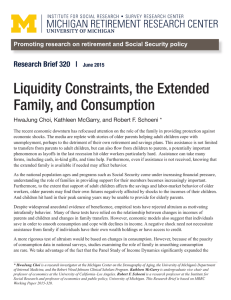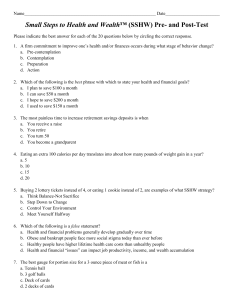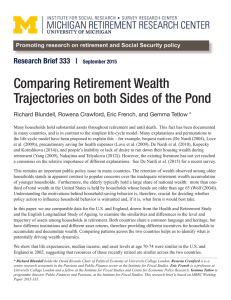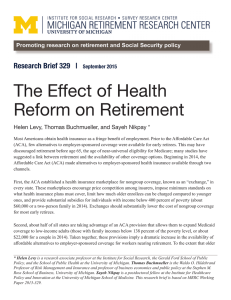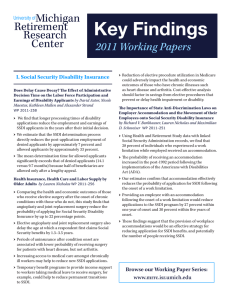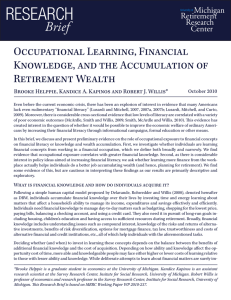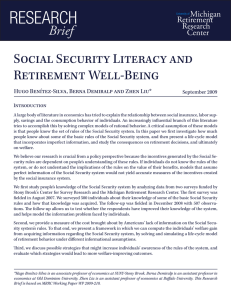Q A ER Q:
advertisement
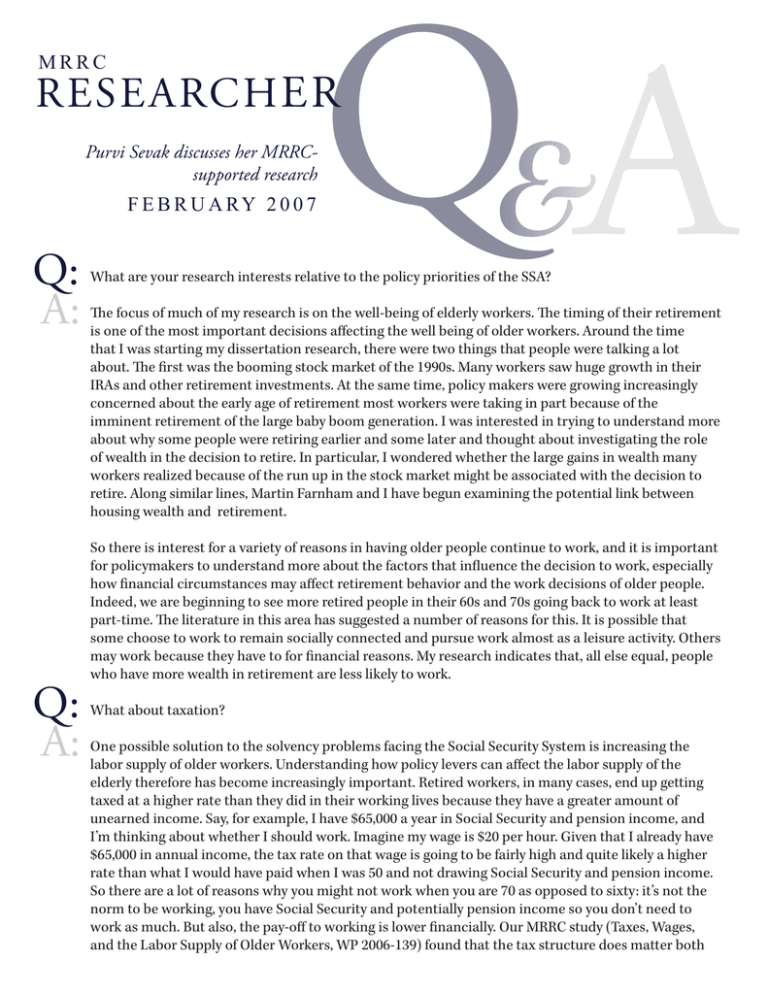
MRRC QA RESEARCH ER Purvi Sevak discusses her MRRCsupported research F E B R U A RY 2 0 0 7 Q: A: What are your research interests relative to the policy priorities of the SSA? The focus of much of my research is on the well-being of elderly workers. The timing of their retirement is one of the most important decisions affecting the well being of older workers. Around the time that I was starting my dissertation research, there were two things that people were talking a lot about. The first was the booming stock market of the 1990s. Many workers saw huge growth in their IRAs and other retirement investments. At the same time, policy makers were growing increasingly concerned about the early age of retirement most workers were taking in part because of the imminent retirement of the large baby boom generation. I was interested in trying to understand more about why some people were retiring earlier and some later and thought about investigating the role of wealth in the decision to retire. In particular, I wondered whether the large gains in wealth many workers realized because of the run up in the stock market might be associated with the decision to retire. Along similar lines, Martin Farnham and I have begun examining the potential link between housing wealth and retirement. So there is interest for a variety of reasons in having older people continue to work, and it is important for policymakers to understand more about the factors that influence the decision to work, especially how financial circumstances may affect retirement behavior and the work decisions of older people. Indeed, we are beginning to see more retired people in their 60s and 70s going back to work at least part-time. The literature in this area has suggested a number of reasons for this. It is possible that some choose to work to remain socially connected and pursue work almost as a leisure activity. Others may work because they have to for financial reasons. My research indicates that, all else equal, people who have more wealth in retirement are less likely to work. Q: A: What about taxation? One possible solution to the solvency problems facing the Social Security System is increasing the labor supply of older workers. Understanding how policy levers can affect the labor supply of the elderly therefore has become increasingly important. Retired workers, in many cases, end up getting taxed at a higher rate than they did in their working lives because they have a greater amount of unearned income. Say, for example, I have $65,000 a year in Social Security and pension income, and I’m thinking about whether I should work. Imagine my wage is $20 per hour. Given that I already have $65,000 in annual income, the tax rate on that wage is going to be fairly high and quite likely a higher rate than what I would have paid when I was 50 and not drawing Social Security and pension income. So there are a lot of reasons why you might not work when you are 70 as opposed to sixty: it’s not the norm to be working, you have Social Security and potentially pension income so you don’t need to work as much. But also, the pay-off to working is lower financially. Our MRRC study (Taxes, Wages, and the Labor Supply of Older Workers, WP 2006-139) found that the tax structure does matter both for the decision to work and the number of hours worked. A higher marginal tax rate on earnings is associated with a lower probability of working and fewer hours of work. Our results suggest that government policies could play a role in increasing the labor supply of older workers by changing the returns to work through the tax code. Q: A: Talk about your interest in the role of gender in retirement well-being? In an earlier MRRC project, David Weir and Bob Willis and I examined the well-being of elderly widows. Social Security has made a large difference for the financial well-being of the elderly. Poverty rates for the elderly are low compared to the average, but there are significant differences along gender and marital status lines with an interaction between the two. In particular, widowed women have very high poverty rates. More recently, Lucie Schmidt and I used data from the PSID and compared wealth among married families, male single households, and female single households (Gender, Marriage, and Asset Accumulation in the United States, WP 2006-109). Although there is a large literature on gender differences in poverty rates, there is little on wealth differences. We find evidence of large differences in wealth between single-female-headed households and married couples. Some of this wealth gap is due to differences in education and earnings. This is not surprising given the well documented gender wage gap. However, even after controlling for earning, along with position in the life cycle and education, a wealth gap persists. We also suspected that there might be cohort differences, as women have increasingly entered the labor force. So we looked at a younger sample of households. We find that even among younger households, single females have lower wealth than single males. However, when we control for earnings, we don’t see the wealth gap. One possibility is that these gaps are disappearing for younger households. It is also possible that these gaps do not emerge until later in life. Q: A: 2 What are you studying right now? There’s a literature on whether people view their housing wealth as real wealth, as money at their disposal. There’s a related literature on how spending might change as housing wealth changes. My current MRRC project with Martin Farnham examines the potential relationship between housing wealth and the decision to retire. We speculate that if people perceive that they have a lot of housing wealth, more than they might have expected to have, they might decide to retire sooner than they had otherwise planned. We use data from the HRS that is GEO coded. The GEO codes allow us to link respondent data to information on local market conditions, including housing values and unemployment. We find that people whose housing increased in value over the ten year period from 1992 to 2002 are likely to retire earlier than those whose house value had lower appreciation. Our results also suggest an asymmetric response. This means that when their housing wealth goes up significantly, people are likely to retire sooner. However, losses in housing value have no impact on retirement timing. MRRC February 2007 Sources: Taxes, Wages, and the Labor Supply of Older Workers by Lucie Shmidt and Purvi Sevak, WP 2006-139. November 2006. Gender, Marriage, and Assett Accumulation in the United States by Lucie Shmidt and Purvi Sevak, WP 2005-109. December 2005. Wealth Shocks and Retirement Timing: Evidence from the Nineties by Purvi Sevak, WP 2002-027. April 2002. The Economic Consequences of Widowhood by Robert Willis, David Weir, and Purvi Sevak, WP 2002-023. April 2002. Purvi Sevak is an Assistant Professor of Economics at Hunter College at the City University of New York. She received her Ph.D. (2002) and M.A. (1998) degrees in Economics at the University of Michigan. She also has a B.S. degree (1991) in Policy Analysis from Cornell University. While at Michigan, Sevak received the Steven Sandell Dissertation award from the MRRC for her research on the effect of capital gains on retirement behavior. Her research portfolio also includes work on the financial consequences of widowhood, the interaction of welfare reform and the SSI program, and the responsiveness of retiree residential location to property taxes. MRRC February 2007 3 THE MICHIGAN RETIREMENT RESEARCH CENTER IS SUPPORTED BY A COOPERATIVE AGREEMENT WITH THE SOCIAL SECURITY ADMINISTRATION (10-P-98362-5-04). DIRECTOR — JOHN P. LAITNER ASSOCIATE DIRECTOR FOR EXTERNAL RELATIONS — AMANDA SONNEGA CENTER ADMINISTRATOR — BECKY BAHLIBI CENTER SECRETARY — JESSICA TAYLOR DESIGN SPECIALIST — KELLYN JACKSON REGENTS OF THE UNIVERSITY OF MICHIGAN Julia Donovan Darlow, Ann Arbor Laurence B. Deitch, Bingham Farms Olivia P. Maynard, Goodrich Rebecca McGowan, Ann Arbor Andrea Fischer Newman, Ann Arbor Andrew C. Richner, Grosse Pointe Park S. Martin Taylor, Gross Point Farms Katherine E. White, Ann Arbor Mary Sue Coleman, ex officio Michigan Retirement Research Center Institute for Social Research University of Michigan 426 Thompson Street, Room 3026 Ann Arbor, MI 48104-2321 Phone: (734) 615-0422 Fax: (734) 615-2180 E-mail: mrrc@isr.umich.edu Web: http://www.mrrc.isr.umich.edu Michigan Retirement Research Center University of
